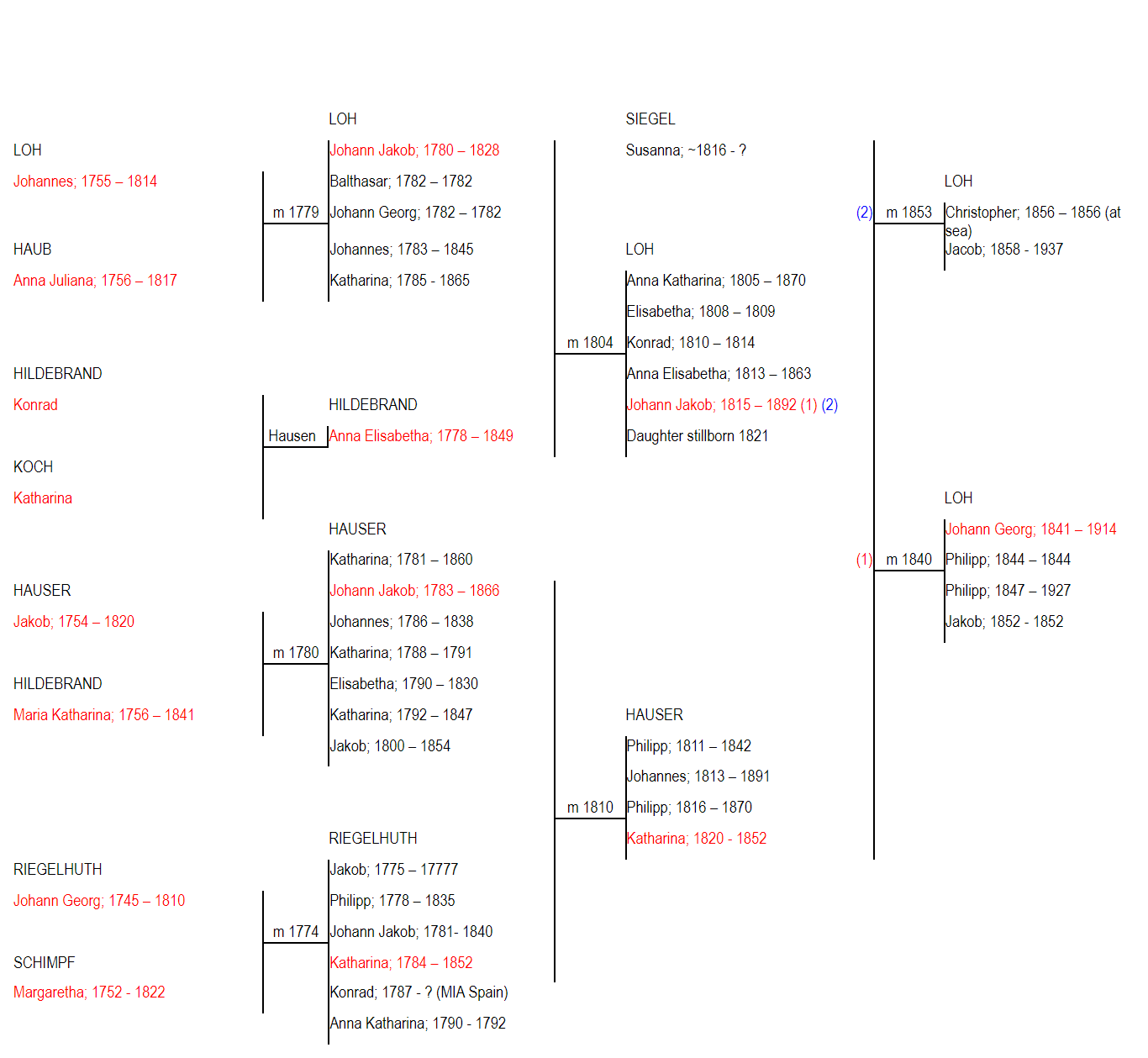Johann Jakob LOH 1815-1892
Johann Jakob was from a family of small farmers – great-great-great-great-grandfather Jakob Luhe is recorded as having paid taxes during the 30 Years War of 1618-48. The menfolk played an active role in church administration; his grandfather and his father before him had served as Church Elders for many years. The loss of their land holdings after the dissolution of the Order of St John compelled Johann Jakob’s father (Johann Jakob I) to support his growing family by weaving linen, for which an acute demand existed in nearby Butzbach.
On 19th December 1804, Johann Jakob senior had married Anna Elisabetha nee Hildebrand. She was from a village in the foothills of the Taunus Ranges, whence she had moved to Nieder-Weisel to look for employment as a domestic servant. Six offspring were born to this marriage but only two girls and Johann Jakob had survived. Born on 1st December 1815, Johann Jakob II was only 12, and still at school, when his father died of apoplexy in 1828. After his military duty Johann Jakob returned to the profession of linen weaving to earn sufficient money to enable him to marry. His fiancee, Katharina Hauser was pregnant by the time they received authority to do so; she gave birth to a child, Johann Georg, twelve weeks after their wedding on 29th November 1840. A second son, Philipp, was born three years later but lived for only a few months.
Conditions in the village continued to worsen and Johann Jakob moved his family to England, finding work as a musician in Derby. Katharina gave birth to another son here. At his baptism in All Saints Church (now Derby Cathedral), he took the name of his dead brother, as was often done. By late 1851 Katharina was pregnant again, and the family went back to Nieder-Weisel. She gave birth to a fourth son, Jakob, on 12th January 1852 but the baby died just a week later. Katharina did not recover from this ordeal; she died four days after her son was laid to rest and she joined him on 26th January.
Jakob returned to Derby, where he married Susanna Siekel on 8th February 1853. His wife was from the small village of Ostheim, 3 km south of Nieder-Weisel. They settled in Derby, where in 1854 Susanna gave birth to a girl, who was named for her mother.
Jakob knew that many of his friends were going to Australia and he decided he would join them. On 5th July 1856 the family sailed from Liverpool aboard the “Morning Light”. Susanna was again pregnant; she produced another son on the journey out but he did not survive and was buried at sea. Their voyage ended in Melbourne on 18th September.
Jakob went prospecting around Ballarat as most of the immigrants did on arrival. Susanna gave birth to a son, Jacob, on 23rd July 1858. Happily this one proved to be robust, although Susanna was by then 43 years of age. Jakob’s German-born son, George, married in 1866 and moved away to Smythesdale and later to Maryborough with his family; eventually, he settled in Gippsland. Jakob and Susanna moved with the other children to the Rocky Lead region, south of Daylesford.
As well as mining operations there was a timber industry, in which Jacob found employment after leaving school. He married late in 1888 and moved with his family to Geelong. His mother had died the year before this marriage, on 3rd July 1887, and was buried in the Mount Prospect cemetery, between Creswick and Daylesford. Johann Jakob moved to Geelong with his son and daughter-in-law; he died in their home in Skene Street Newtown in 1892 in his 77th year.
View Johann Jakob's Family Chart

